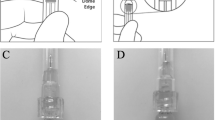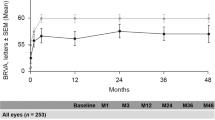Abstract
Purpose
The objective of this study is to estimate the incidence of steroid-induced severe intraocular pressure (IOP) rise following intravitreal triamcinolone acetonide (IVTA) injection and to describe case profiles of the patients affected within the United Kingdom.
Patients and methods
A national survey was carried out to identify cases that had developed severe IOP rise requiring laser or surgery following IVTA through the British Ophthalmic Surveillance Unit. Respondents were mailed a questionnaire and with a follow-up questionnaire 1 year later, to ascertain characteristics of the patients identified. We also carried out a midpoint survey to ascertain national practice of IVTA at the time.
Results
There were 29 confirmed reports of severe IOP rise after IVTA in the13-month period of surveillance. All the cases were unilateral and the mean time between the IVTA and the maximum recorded IOP was 16 weeks. Six of these patients had pre-existing glaucoma or ocular hypertension, and a further two were known to be ‘steroid responders’. Using the adjusted denominators, obtained from our national survey, the estimated annual incidence would be between 3.6 and 9.5 per 1000 injections.
Conclusions
These results confirm that severe IOP rise after IVTA is an uncommon but serious complication. Data obtained from this national study should aid clinicians in choosing the treatment best suited to their patients.
Similar content being viewed by others
Introduction
Triamcinolone acetonide is a synthetic corticosteroid with marked anti-inflammatory properties that has been used to treat macular oedema of various aetiologies, including choroidal neovascularization,1 diabetic retinopathy,2 vein occlusions,3 and non-infectious uveitis.4
The safety of intravitreal triamcinolone acetonide (IVTA) has been well documented in both animal studies as well as human trials.5 However, IVTA is associated with potential complications, including intravitreal haemorrhage, retinal tears, lens opacifications, and acute as well as sustained rise in intraocular pressure (IOP). Severe and sustained IOP rise secondary to steroid use can cause sight loss, usually through glaucomatous damage to the optic nerve.6
We previously carried out a national survey of cases of severe elevation in IOP following IVTA. The phenomenon appears to be an extreme form of ‘steroid-induced glaucoma’. At the time of the survey, usage of IVTA appeared to be increasing,7 and there was concern over increasing numbers of case reports of sight-threatening IOP rise.
This study was carried out to estimate the incidence of steroid-induced severe IOP rise following IVTA and to describe case profiles of the patients affected.
Materials and methods
The survey was conducted through the British Ophthalmic Surveillance Unit (BOSU), which exists to enable case ascertainment for studies of rare conditions in ophthalmology.8 Every month, BOSU mails a postcard to all UK ophthalmologists (consultant or associate specialist grade), asking them whether they have seen any cases from a small list of conditions under surveillance, or none. When a respondent states that they have seen a case, BOSU alerts the investigators, who send a questionnaire.
For the purpose of this study, we defined a ‘Severe IOP rise’ after IVTA as one that was treated with surgery and/or laser to lower the IOP. Respondents were mailed a questionnaire and with a follow-up questionnaire 1 year later. We also carried out a mid-point survey (postal questionnaire to all ophthalmologists on the BOSU database), in order to ascertain practice at the time. We asked about number of IVTA treatments in the previous year, and indications. This gave us the denominator for our calculations of incidence of ‘Severe IOP rise’ after IVTA. The survey forms for this mid-point questionnaire were unmarked and anonymous in order to encourage full and frank reporting, but this meant we could not send reminders to non-responders.
The survey was on the BOSU card system for 13 months from May 2008 to May 2009. At the time, the national card return rate was 77%. The first month acted as a pilot; hence, the incidence calculations are based on the 12-month period from 1 June 2008 to 31 May 2009. However, all cases reported have been included in the clinical data set.
Results
Survey of IVTA practice in the United Kingdom in 2009
The response rate was 51.3% (575/1120 ophthalmologists). Among respondents, 35.1% (202/575) had used IVTA during the previous 12 months. They estimated that they had treated a total of 3716 patients. The commonest indications for treatment were diabetic macular oedema (40.8%, 1514/3716), uveitic macular oedema and/or posterior segment inflammation (18.2%, 677/3716), postoperative cystoid macular oedema (17.3%, 645/3716), vascular occlusive disease (16.1%, 598/3716), and age-related macular degeneration (3.3%, 124/3716). Of those using IVTA, 15.8% (32/202) viewed pre-existing glaucoma as an absolute contraindication to IVTA, 73.3% (148/202) thought glaucoma was a relative contraindication, and 6.9% (14/202) thought glaucoma was not a contraindication to IVTA.
These data were used to estimate the denominator for the incidence of severe IOP rise. The analysis has been based on the reported number of injections, the estimated number based on the assumption that the rate of IVTA usage in non-responders was the same as that of responders. However, it is most likely to be that more of the non-responders were also non-users of IVTA. To compensate for this, we have also used a mid-range estimate between the upper and lower estimates to provide a key estimate of the true incidence. The total number of reported IVTA injections in 2009 was 3716; the upper estimate is calculated to be 7238 (3716 × 1120/575) with a mid-range estimate of 5747.
Reports of ‘Severe IOP rise’
There were 29 confirmed reports of ‘Severe IOP rise’ after IVTA in the13-month period of surveillance. This gave a reported annual incidence of 7.2 per 1000 for severe IOP rise after IVTA injections. Using the adjusted denominators, the incidence would be estimated at 4.6 per 1000 injections. These were in 29 eyes of 29 patients and no patient had bilateral involvement.
The mean age of these 29 patients was 60.9 (43–81) years with a men:women ratio of 15 : 14. Six of these patients had pre-existing glaucoma or ocular hypertension (20.7%), a further two were known to be ‘steroid responders’ (previous IOP rise in response to topical steroid), and two patients had previous intraocular inflammation. Five of these patients were pseudophakic (one had a capsular tension ring, one had an extracapsular cataract extraction). ‘Severe IOP rise’ occurred after first IVTA injection in 12 patients (41.3%); after the second IVTA to the eye in 10 (34.5%), after the third IVTA in 4 (13.8%), and after the fourth IVTA in 3 patients (10.3%).
The mean time between the IVTA and the maximum recorded IOP was 16 weeks (range: 1.5–71 weeks).
The mean peak IOP at the time of decision to operate or to carry out laser was 45.6 mm Hg (range: 26–75). Of these 29 patients, 5 underwent laser (cyclodiode (3), selective laser trabeculoplasty(1), argon laser trabeculoplasty (1)), 2 underwent tube surgery (1 Baerveldt and 1 Ahmed implant), and the rest underwent trabeculectomy (22). Of the operated patients, one developed rubeotic glaucoma and two developed cataract. None underwent further surgery or laser for glaucoma, during our follow-up period of 13 months. There were two reported adverse events of postoperative cataract formation and one episode of anterior chamber deposits of the triamcinolone.
Discussion
These results confirm our impression that severe IOP rise after IVTA is uncommon. Estimating the true incidence is made complex by bias introduced through possible underascertainment inherent in case identification through surveillance and the estimate of the denominator. Previous BOSU studies have indicated that case ascertainment is reported to be between 75 and 95%,3 meaning that there may have been 39 cases during the study period. We believe that it is likely to be that the true incidence of severe IOP rise after IVTA will lie between 3.6 (26.7/7238) and 9.5 per 1000 injections. This range is derived from using the reported cases divided by the higher denominator and the adjusted number of cases allowing for underascertainment divided by the reported denominator. We carried out a national survey while planning this survey2 and this indicated that the rate was in the order of 1.1%. Therefore, it appears that the rate of severe IOP rise after IVTA is in the order of 1%. The high prevalence of patients with a prior ‘glaucoma’ diagnosis gives support to the widely held view that these patients are at higher risk of developing severe IOP rise after IVTA. However, the study design did not allow us to be certain about this, because we were unable to ascertain how many of the uncomplicated IVTA cases had a glaucoma diagnosis.
Since this study was carried out, newer treatments have become available for many of the conditions treated. These include other intraocular steroids, and non-steroid treatments such as intravitreal inhibitors of vascular endothelial growth factor.9 However, due to its low cost and efficacy in treating macular oedema, IVTA still remains a valid alternative to the therapies on offer.10, 11
The results of this study should assist clinicians in choosing which treatment is best for their patients, and also in defining the risks of severe IOP rise in patients who need intravitreal steroid injections.

References
Danis RP, Ciulla TA, Pratt LM, Anliker W . Intravitreal triamcinolone acetonide in exudative age-related macular degeneration. Retina 2000; 20 (3): 244–250.
Martidis A, Duker JS, Greenberg PB, Rogers AH, Puliafito CA, Reichel E et al. Intravitreal triamcinolone for refractory diabetic macular edema. Ophthalmology 2002; 109 (5): 920–927.
Ding X, Li J, Hu X, Yu S, Pan J, Tang S . Prospective study of intravitreal triamcinolone acetonide versus bevacizumab for macular edema secondary to central retinal vein occlusion. Retina 2011; 31 (5): 838–845.
Young S, Larkin G, Branley M, Lightman S . Safety and efficacy of intravitreal triamcinolone for cystoid macular oedema in uveitis. Clin Exper Ophthalmol 2001; 29 (1): 2–6.
McCuen BW . The lack of toxicity of intravitreally administered triamcinolone acetonide. Am J Ophthalmol 1981; 91 (6): 785–788.
Razeghinejad MR, Katz LJ . Steroid-induced iatrogenic glaucoma. Ophthal Res. 2012; 47 (2): 66–80.
Jain S, Hurst JR, Thompson JR, Eke T . UK national survey of current practice and experience of intravitreal triamcinolone acetonide. Eye (Lond) 2009; 23 (5): 1164–1167.
Foot B, Stanford M, Rahi J, Thompson J, British Ophthalmological Surveillance Unit Steering Committee. The British Ophthalmological Surveillance Unit: an evaluation of the first 3 years. Eye (Lond) 2003; 17 (1): 9–15.
Mitry D, Bunce C, Charteris D . Anti-vascular endothelial growth factor for macular oedema secondary to branch retinal vein occlusion. Cochrane Database Syst Rev 2013; 1: CD009510.
Zhang Y, Ma J, Meng N, Li H, Qu Y . Comparison of intravitreal triamcinolone acetonide with intravitreal bevacizumab for treatment of diabetic macular edema: a meta-analysis. Curr Eye Res 2013; 38 (5): 578–587.
Gokce G, Sobaci G, Durukan AH, Erdurman FC . Intravitreal triamcinolone acetonide compared with bevacizumab for the treatment of patients with macular edema secondary to central retinal vein occlusion. Postgrad Med 2013; 125 (5): 51–58.
Acknowledgements
This study was supported by the British Ophthalmic Surveillance Unit and a bursary from ‘Fight for Sight’.
Author information
Authors and Affiliations
Corresponding author
Ethics declarations
Competing interests
The authors declare no conflict of interest.
Rights and permissions
About this article
Cite this article
Jain, S., Thompson, J., Foot, B. et al. Severe intraocular pressure rise following intravitreal triamcinolone: a national survey to estimate incidence and describe case profiles. Eye 28, 399–401 (2014). https://doi.org/10.1038/eye.2013.306
Received:
Accepted:
Published:
Issue Date:
DOI: https://doi.org/10.1038/eye.2013.306



